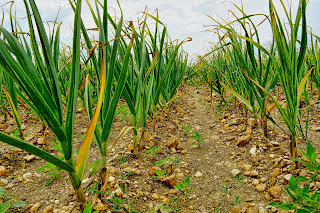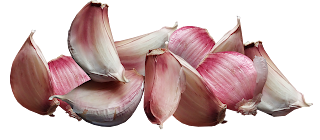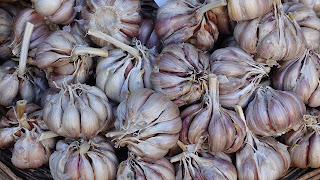Horticulture Guruji
Garlic Cultivation
Lahsoon, Lahsun, Lassan, Poodu
Garlic (Allium sativum) in India is also known as ‘Lahsoon’. Garlic is an important bulb crop grown and used as a spice or condiment throughout India. It is mainly cultivated in Madhya Pradesh, Gujarat, Orissa, Maharashtra, Uttar Pradesh Rajasthan, and Tamil Nadu. But 50% of the total production is only from Madhya Pradesh and Gujarat states. Garlic has medicinal use in sore eyes, cough, and lung diseases. It is used in vegetables and meat to give flavour as a spice. In this chapter, you will read in detail about its cultivation.
Watch Lecture Video
Botanical Name: – Allium sativum
Family: – Alliaceae / Lilliaceae / Amaryllidaceae
Chromosome No.: – 2n=16
Origin: – Central Asia
Edible part: – Bulb (Cloves)

Important Points
- The aroma in garlic is due to Diallyl disulphide.
- China ranks first in Production.
- Cultivated Indian varieties are short-day types.
- Egypt rank first in productivity.
- India ranks third in production and second in the area in the world.
- An antibacterial substance Allicin present in garlic.
- The water-soluble amino acid present in garlic- Allin.
- Garlic is a sexually sterile diploid.
- Longer day length 12 hr or more give a higher bulb yield.
- Garlic is used to cure whooping cough, lung diseases, ulcer, sore eyes, earaches, and disorders resulting from childbirth.
- It contains 62.2 gm moisture, 6.3 gm protein, 29.0 gm carbohydrates, 30.0mg calcium 0.16mg Riboflavin, and 13.00 mg Vitamin C per 100g edible portion.
- Curing:- A process to remove excess moisture.
Area and Production
- It is mainly cultivated in Madhya Pradesh, Gujarat, Orissa, Maharashtra, Uttar Pradesh Rajasthan, and Tamil Nadu.
- 50% of the total production is only from Madhya Pradesh and Gujarat states.
- In India garlic has grown an area of 3,17,000 ha with 16,11,000 MT production.

Varieties
- Agrifound white (G-41) TSS-41, grown in MH
- Agrifound Parvati G-313)- long day, suitable for northern hills, big-sized cloves.
- Godavari
- Yamuna Safed (G-1)- TSS 38-40, suitable for North India.
- Yamuna Safed-2 (G-50)
- HG-1 :- Suitable for Haryana
- HG-6
Climate
Garlic is a hardy crop and is tolerant to frost. The climatic requirement of garlic is similar to onion and in India, it is mainly cultivated in the winter season. It prefers a mild climate that is not so hot nor cool. Garlic Requires a cool and moist climate at the time of plant growth and a dry climate at maturity. The critical day length for bulb development is 12 hours. Indian varieties perform better in short-day conditions.
Soil
Garlic can be grown in all types of soil such as light sandy loam to heavy clay but loam soil is best for cultivation. Soil should be rich in organic matter, deep and fertile. In light or loose soil poor bulb development and in heavy soil make misshaped bulbs. Soil pH ranging should be between 6-7. Garlic is sensitive to highly acidic and alkaline soils.
Sowing Time
- North India – September-October
- Hills- March-April
- South India- August- November

Seed Rate
About 500-700 Kg cloves are needed for one hectare.
Sowing Method
There are three methods of garlic sowing
- Dibbling:- Garlic healthy cloves are generally planted by dibbling method 5-7.5cm deep, 7.5 cm apart from each other in rows 15 cm apart, and then cover with a layer of soil. Immediately after sowing irrigates the crop.
- Furrow Planting:- In this method 15 cm apart furrows are made with the help of a small hand hoe or cottonseed drill. In furrow, cloves are dropped with hand about 8-10 cm apart and covered with soil followed by irrigating the crop.
- Broadcasting Method:- In this method field is divided into convenient-sized flatbeds. Then the cloves are broadcast or spread with hand all the bed evenly and covered with soil over by harrowing. After sowing irrigates the crop immediately.
Manure and fertilizers
Generally, 50 tonnes/ha FYM should be added at the time of the first ploughing. Garlic is a heavy feeder of manures and fertilizers. Garlic requires 100 Kg/ha N, 50 Kg/ha of P and K each. It requires micronutrients in small amounts viz. 5 Kg/ha B, 5 Kg/ha Zn, and 5 Kg/ha Mo. Half dose of N, a full dose of P, K, B, Zn, and Mo should be applied at the time of sowing. The remaining dose of N is given one month after sowing as a top dressing. Some studies say that 75 kg/ha fertilizer mixture of NPK as a ratio of 18:2:3 should be added to soil at the time of sowing increase yield along with 5Kg/ha B, Zn, and Mo each.
Irrigation
The first irrigation is given to the crop immediately after the sowing of cloves. The crop should be irrigated at an interval of 10–15 days until the climate is warm. After that, the crop should be irrigated at short intervals. Soil moisture is required at the time of bulb growth if moisture stress at that time will adversely affect bulb growth. The crop should be irrigated 3-4 days before harvesting so that the bulb can be dug easily.
Weed Control
Garlic is a shallow-rooted crop so frequent shallow cultivation should be given to the soil to kill the weeds and loosen the soil around the plant. Generally, 2-3 hoeing cum weeding is done during the initial 1st 2 months of growth. Some post-emergence herbicides like Simazine or Dizuron (0.75-1.0Kg/ha) are also effective to control weeds.
Use of PGR
|
Sr.No. |
Chemical/PGR’s |
Doses |
Effectiveness |
|
1 |
GA3 |
200-400ppm |
Enhance bulblet formation, Increase the number of cloves per bulb, delay in leaf formation in storage |
|
2 |
BA (Benzylaenene) |
50-100ppm |
Induce lateral bud formation |
|
3. |
Ethrel |
960-1920ppm |
Inhibited plant height and storage leaf formation, increase leaf width. |
|
4 |
NAA |
50-800ppm |
Inhibited the formation and development of storage leaf. |
Harvesting
Garlic should be harvested when leaves turn yellow or dry. The crop should be irrigated 3-4 days before harvesting so that the bulb can be dug easily. The bulbs are lifted with spade or khupi, free from earth, and make a bundle with tying the top leaves. These bundles for curing are put in shade for 3-4 days. After curing, top leaves are removes and store in ordinary rooms.
Yield
The yield ranging between 10-20 t / ha depending upon the variety, soil, applied fertilizers.
Insect pest management
- Thrips (Thrips tabacii):- Yellowish small insect sac the sap from leaves and silver-coloured strips or brown spots are seen on leaves.

Control
- Spray with 0.05% Monocrotophos, or Methyl demeton or Neem carnal oil.
- Onion Fly or Maggots (Delia antiqua) :- Small grey fly such as house fly lays an egg in the soil around the plant. After the attack of this insect turn lower leaves yellow.

Control
- Spray on the crop with 0.1 % Malathion to control the onion fly.
Disease management
- Purple Blotch (Alternaria porri):- Most favourable temperature for the disease is 280-300C. This disease is more prevalent when heavy rainfall or planting is done in closer spacing. Purplish spots are seen on leaves.

Control
- When the disease has been seen spray with Endofil M-45 @ 2.5 gm/Littre of water at 10-15 days interval.
Physiological disorders
- Bulb sprouting: – Sprouting is a major problem in long-term storage.

Causes
- Use of excess nitrogen in the field
- High soil moisture during harvesting.
Management
- Avoided excess irrigation
- Apply a recommended dose of nitrogen fertilizers.
- Maintain proper storage facilities like ventilation, temperature, humidity
- Proper curing of the bulb before storage.
- Splitting:- Splitting is also a major disorder of garlic when delayed in harvesting. In this disorder bulb does not remain compact and it is burst.

Management
Harvesting should be done at the right stage or time.
